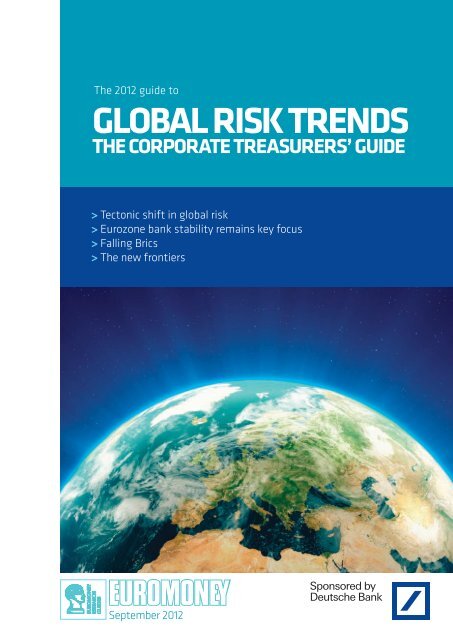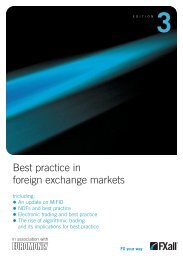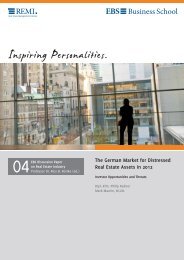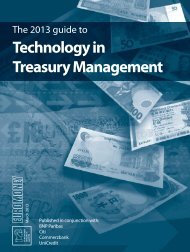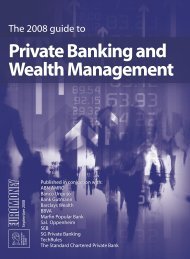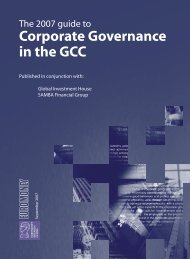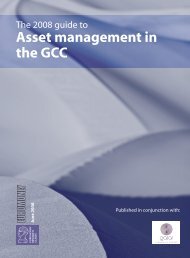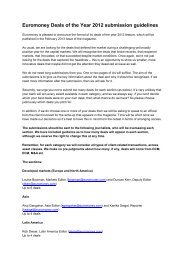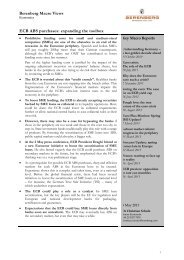Download guide (PDF) - Euromoney
Download guide (PDF) - Euromoney
Download guide (PDF) - Euromoney
You also want an ePaper? Increase the reach of your titles
YUMPU automatically turns print PDFs into web optimized ePapers that Google loves.
The 2012 <strong>guide</strong> to<br />
GLOBAL RISK TRENDS<br />
THE CORPORATE TREASURERS’ GUIDE<br />
> Tectonic shift in global risk<br />
> Eurozone bank stability remains key focus<br />
> Falling Brics<br />
> The new frontiers<br />
September 2012
2<br />
The 2012 <strong>guide</strong> to<br />
GLOBAL RISK TRENDS
The 2012 <strong>guide</strong> to Global Risk Trends<br />
CONTENTS<br />
> Navigating the new risk landscape 4<br />
> Tectonic shift in global risk 6<br />
> Eurozone bank stability remains key focus 8<br />
> SEPA - The clock is ticking 12<br />
> The disease is spreading 15<br />
> Falling Brics 18<br />
> The new frontiers 21<br />
This <strong>guide</strong> is for the use of professionals only. It states the position of the market as at the time of going to press and is not a substitute<br />
for detailed local knowledge.<br />
<strong>Euromoney</strong> Institutional Investor PLC<br />
Nestor House, Playhouse Yard, London EC4V 5EX<br />
Telephone: +44 20 7779 8888 Facsimile: +44 20 7779 8739 / 8345<br />
Directors: Sir Patrick Sergeant, The Viscount Rothermere, Richard Ensor (managing director), Neil Osborn, Dan Cohen, John Botts,<br />
Colin Jones, Diane Alfano, Christopher Fordham, Jaime Gonzalez, Jane Wilkinson, Martin Morgan, David Pritchard, Bashar Al-Rehany<br />
Editor: Philip Ayers<br />
Printed in the United Kingdom by: Wyndeham, Roche, UK<br />
© <strong>Euromoney</strong> Trading London 2012. <strong>Euromoney</strong> is registered as a trademark in the United States and the United Kingdom.
4<br />
The 2012 <strong>guide</strong> to<br />
GLOBAL RISK TRENDS<br />
Navigating the new risk<br />
landscape<br />
The world is becoming an increasingly risky place to do<br />
business. Corporates must adapt to a new risk paradigm,<br />
with a greater range of risks to mitigate than ever before.<br />
To avoid pitfalls, expertise and a broader understanding<br />
of global risk are required. Michael Spiegel, Head of Trade<br />
Finance and Cash Management Corporates, Deutsche Bank<br />
Since 2008, the overall risk<br />
environment for corporates has<br />
been transformed by waves of<br />
financial, economic and liquidity<br />
crises that has swept through many<br />
developed economies. As we approach the<br />
end of the year, there are few who think<br />
that 2013 will be any easier. The slowdown<br />
across the emerging markets appears<br />
to be gathering pace, while geopolitical<br />
uncertainties persist in many of the<br />
world’s regions.<br />
Businesses must identify the key risks<br />
to which they are exposed if they are to<br />
navigate such troubled waters successfully.<br />
At Deutsche Bank, we identify four key risk<br />
trends facing our clients in 2013.<br />
We take time to get a<br />
deeper understanding of<br />
the client, its processes and<br />
its internal challenges and<br />
targets, to see how we can<br />
add value to its operations”<br />
Firstly, as corporate default rates<br />
begin to increase, so companies face<br />
increased commercial counterparty risk.<br />
Correspondingly, there is an increasing need<br />
to hedge that counterparty default risk.<br />
Next, clients also face counterparty<br />
risk relating to financial institutions.<br />
Managing their concentration risk has<br />
become all important, with far more<br />
attention paid to the credit quality of<br />
each individual counterparty. The times<br />
are over when corporates were willing to<br />
deal with one bank only.<br />
Thirdly, geopolitical risk now plays a<br />
bigger part in our clients’ thinking. As<br />
a result, we see an increase in hedging<br />
against country risk, and a greater focus<br />
on geopolitical strategy.<br />
Fourthly, many suppliers and distributors<br />
are experiencing a continuing liquidity<br />
shortage. As a result, mitigating supply<br />
chain risk is a growing theme for our<br />
clients. This often means companies must<br />
look beyond the risks to their own legal<br />
entity and consider the totality of the<br />
supply chain.
The 2012 <strong>guide</strong> to<br />
GLOBAL RISK TRENDS<br />
5<br />
In short, firms must identify all the<br />
different risk pockets in their organization,<br />
including the broader enterprise risk<br />
outside their own legal entity. Then,<br />
they must determine a suitable strategy<br />
to mitigate these risks. They will face<br />
decisions over where to pool their cash,<br />
how best to hedge their positions, how<br />
to get their chosen banks involved and<br />
whether to use private risk insurers.<br />
Finally, when evaluating a potential<br />
banking partner, in addition to evaluating<br />
credit and jurisdictional issues, clients<br />
must ask themselves a further question: Is<br />
the prospective partner committed to the<br />
business for the long term? Does it have<br />
the critical mass to stay in the business<br />
for 10 years? Can it manage the business<br />
successfully, and is it willing to invest in<br />
already-excellent technology and services<br />
for a sustained period?<br />
The pace of globalization means that<br />
companies now have counterparties in<br />
more countries than ever, in addition to<br />
foreign subsidiaries and joint ventures.<br />
We continue to support our clients,<br />
bringing them expertise with in-country<br />
client implementation and service through<br />
our network of offices around the world.<br />
Our solutions-based approach uses<br />
superior technology and state-of-the-art<br />
products that help our clients stay abreast<br />
of continuing developments. With the<br />
needs of the client at the heart of our<br />
business, we will continue to invest and<br />
expand to meet the challenging global<br />
business environment.<br />
Focusing on clients’ needs<br />
At Deutsche Bank, our superior approach<br />
to cash management and treasury services<br />
starts with our focus on the needs of<br />
the clients. We take time to get a deeper<br />
understanding of the client, its processes<br />
and its internal challenges and targets, to<br />
see how we can add value to its operations,<br />
rather than simply turning up with a basket<br />
of products in which we have an edge.<br />
We pride ourselves on our state-of-the-art<br />
technology solutions. We utilize the close<br />
links with colleagues in our award-winning<br />
sales or trading teams to provide hedging<br />
and FX strategies tailored to the needs of<br />
our clients. We also provide liquidity not<br />
only by making use of our balance sheet<br />
and sharing the risk with other banks,<br />
but also looking for innovative solutions,<br />
broadening the investor base over time.
6<br />
The 2012 <strong>guide</strong> to<br />
GLOBAL RISK TRENDS<br />
Tectonic shift in global risk<br />
Global risk patterns have altered substantially in recent<br />
decades. Whereas once Europe offered comparative safety<br />
for treasury operations, today the eurozone crisis has<br />
accentuated the risks associated with cash management<br />
and supply finance. But while the debt crisis is deepening<br />
and infecting other parts of the world, according to<br />
<strong>Euromoney</strong>’s Country Risk Survey, it is not the only factor<br />
destabilizing the global outlook<br />
The world has changed. That<br />
much is certain. Some 20 years<br />
ago Japan was considered the<br />
safest sovereign, according to<br />
<strong>Euromoney</strong>’s Country Risk Survey, with<br />
a rock-solid score of 99.4 out of a possible<br />
100 points. Today, Japan doesn’t even make<br />
the top 20. Instead it can be found nestling<br />
between Slovakia and South Korea at 24<br />
in ECR’s global rankings, weighed down<br />
by concerns about its economy, public<br />
finances and government stability. Two<br />
decades ago, Spain was exhibiting fewer<br />
of the problems that have made it such a<br />
The World's "Safest" Sovereigns<br />
The Leaders Overall Global …and 20 Overall<br />
Today… ECR Score Rank Years Ago ECR Score<br />
Norway 90.4 1 Japan 99.4<br />
Switzerland 88.8 2 United States 99.1<br />
Singapore 88.0 3 Switzerland 99.0<br />
Luxembourg 87.9 4 France 98.5<br />
Sweden 86.8 5 Netherlands 98.2<br />
Finland 84.3 6 Austria 97.9<br />
Canada 84.3 7 Germany 97.9<br />
Denmark 83.5 8 United Kingdom 97.8<br />
Netherlands 83.1 9 Canada 97.8<br />
Germany 82.2 10 Belgium 96.9<br />
Hong Kong 82.2 11 Luxembourg 95.8<br />
Australia 81.6 12 Denmark 95.2<br />
New Zealand 80.7 13 Norway 94.7<br />
Austria 79.8 14 Singapore 92.5<br />
United States 75.7 15 Australia 92.5<br />
Chile 74.9 16 Sweden 92.5<br />
Taiwan 74.7 17 Spain 91.2<br />
United Kingdom 74.2 18 Finland 91.2<br />
France 73.9 19 New Zealand 91.1<br />
Qatar 73.1 20 Ireland 90.5<br />
Source: <strong>Euromoney</strong> Country Risk
The 2012 <strong>guide</strong> to<br />
GLOBAL RISK TRENDS<br />
7<br />
high-risk sovereign today, indistinguishable<br />
from Finland on a score of 91.2. Ireland,<br />
ranking 20th when the survey began (but<br />
now down to 48th), and Italy, bubbling<br />
just below the surface in 24th position<br />
(currently 41st), were also considered much<br />
safer sovereigns for global treasurers. In<br />
fact, all of the top-ranking ECR countries in<br />
1992 now have reduced scores. The world<br />
has indeed become a riskier place.<br />
Even in 1999, when the euro project reshaped<br />
Europe’s boundaries, exactly half of<br />
the top 20 safest sovereigns in the world<br />
were eagerly awaiting conversion to the<br />
single currency. With banking systems<br />
superficially secure, the distress seen<br />
today seemed a distant prospect. Eurozone<br />
participants had, after all, signed up to<br />
macroeconomic stability, dispensing with<br />
their mostly-depreciating currencies, high<br />
inflation and weak, uncompetitive growth<br />
rates, by locking in to Germany’s strong<br />
economy and pocketing the ‘insurance<br />
policy’ offered by the ECB’s pooled reserves<br />
and apparently strict membership rules.<br />
Or so it seemed. Today, only six countries<br />
out of an expanded 17-nation euro currency<br />
area are among the world’s top 20 ‘safest’.<br />
And with France slipping to 19th in ECR’s<br />
rankings this year, it may not be too long<br />
before there are just five.<br />
As the risks surrounding Europe’s debt<br />
problems mount, so the rest of the world is<br />
also becoming less safe – a worrying sign for<br />
treasury managers. Virtually all of the other<br />
main regions/economic groups have become<br />
riskier so far this year, led by the emerging<br />
powerhouses (the BRICs), Central and<br />
Eastern Europe and the Middle East. But<br />
it’s a pattern that cannot be explained by<br />
contagion alone, even if Europe’s problems<br />
have invariably led ECR’s survey contributors<br />
to reassess the risk outlook as exports and<br />
capital flows are affected. A combination<br />
of economic, political and structural factors<br />
is to blame. They range from bank stability<br />
risk, transfer risk (the risk of government<br />
non-payment/non-repatriation), currency<br />
stability risk and the risks associated with<br />
the regulatory and policy environment to<br />
political factors, concerning institutions<br />
and government stability, all of which have<br />
particular relevance to corporate treasury<br />
decision-making.<br />
More than 400 economists and country<br />
risk experts from a range of financial and<br />
other institutions take part in <strong>Euromoney</strong>’s<br />
Country Risk Survey. They evaluate the<br />
risks faced by international investors in<br />
186 markets worldwide, scoring countries<br />
across a range of political, economic and<br />
structural risk criteria. The ECR survey<br />
combines these contributor assessments<br />
on 15 of the most important risk factors<br />
with other data regarding access to capital,<br />
credit ratings and debt, to formulate an<br />
overall score out of 100 (where 100 is<br />
the least risky and zero the most). The<br />
survey has been undertaken since late<br />
1992 and is updated daily on a ‘real-time’<br />
basis, with scores collated and aggregated<br />
each quarter for comparison purposes.<br />
It can therefore provide an early warning<br />
indicator of emerging risks, distinct from<br />
the sovereign credit ratings supplied by<br />
the various ratings agencies. Further<br />
information on the survey is available from:<br />
www.euromoneycountryrisk.com.<br />
“ As the risks surrounding Europe’s<br />
debt problems mount, so the<br />
rest of the world is also becoming<br />
less safe – a worrying sign for<br />
treasury managers
8<br />
The 2012 <strong>guide</strong> to<br />
GLOBAL RISK TRENDS<br />
Eurozone bank stability<br />
remains key focus<br />
Far from stabilizing, the risks associated with the eurozone<br />
debt crisis are still rising and infecting other parts of the world,<br />
as banking sector problems deepen and extend their reach<br />
Bank stability has become an<br />
increasingly dominant factor<br />
for counterparties and deposit<br />
holders seeking safety. Each of<br />
ECR’s country experts is asked to quantify<br />
bank stability risk, by awarding a score<br />
ranging from 10, typifying a perfectly<br />
functioning system where all possible<br />
exposures are comfortably covered, to<br />
zero, where a systemic breakdown in the<br />
banking system has occurred.<br />
Interestingly, bank stability and<br />
government debt appear to go hand in<br />
hand. High scores are correlated with low<br />
levels of debt and vice versa, with some<br />
exceptions. Finland, Luxembourg and<br />
Slovakia, the three countries with the<br />
highest bank stability scores, have low<br />
levels of debt (below the EU’s 60% of GDP<br />
limit). Greece, Ireland, Portugal and Italy,<br />
those eurozone sovereigns with the lowest<br />
bank stability scores, all have triple-digit<br />
public debt ratios.<br />
The correlation is similar for bank<br />
stability and another of ECR’s surveyed<br />
indicators, government finances. A<br />
higher bank stability score is generally<br />
linked to a higher score for government<br />
finances, while the opposite is also true.<br />
This link between sovereign debt and<br />
bank stability is explained in an article<br />
by Michael Davies and Tim Ng, ‘The rise<br />
Eurostat<br />
180<br />
160<br />
140<br />
120<br />
100<br />
80<br />
60<br />
40<br />
20<br />
0<br />
General Government Debt, % of GDP (y-axis)<br />
vs ECR Bank Stability Scores (x-axis)<br />
Source: <strong>Euromoney</strong> Country Risk; Eurostat<br />
0 1 2 3 4 5 6 7 8 9 10
The 2012 <strong>guide</strong> to<br />
GLOBAL RISK TRENDS<br />
9<br />
of sovereign credit risk: implications<br />
for financial stability’, in the December<br />
2011 Bank for International Settlements<br />
(BIS) Quarterly Review. The authors<br />
describe how “deterioration in sovereign<br />
creditworthiness drives up banks’ funding<br />
costs and impairs their market access.<br />
Moreover, due to the extensive role of<br />
government securities in the financial<br />
system, banks cannot fully insulate<br />
themselves from higher sovereign risk by<br />
changing their operations.”<br />
With Spain acknowledging it will require<br />
a €100 billion bank bail-out, Italy also<br />
edging toward default, and wider fears over<br />
sovereign debt dynamics as many countries<br />
fail to find the recipe for economic growth,<br />
the health of the region’s financial<br />
system continues to cause alarm. All 17<br />
eurozone sovereigns have succumbed<br />
to increased bank stability risk this year,<br />
perpetuating the trend decline. There is<br />
nonetheless considerable variation among<br />
member states. Spain’s bank stability<br />
10<br />
9<br />
8<br />
7<br />
6<br />
5<br />
4<br />
3<br />
2<br />
1<br />
0<br />
ECR Government Finances Scores (y-axis) vs<br />
Bank Stability Scores (x-axis)<br />
Source: <strong>Euromoney</strong> Country Risk<br />
0 1 2 3 4 5 6 7 8 9 10<br />
Davies and Ng further explain how<br />
deterioration in a ‘home sovereign’ credit<br />
rating - the country in which a bank is<br />
headquartered – is revealed in a rise in<br />
the banks’ credit default spreads (the<br />
cost of insuring against a debt default),<br />
a fall in short-term debt issuance and<br />
a drain on deposits. Four channels<br />
are identified by which sovereign risk<br />
affects banks’ funding: losses on<br />
sovereign holdings, lower collateral<br />
values for wholesale and central bank<br />
funding, reduced funding benefits from<br />
government guarantees and depressed<br />
credit ratings.<br />
score has fallen aggressively, of course,<br />
and it is now the third riskiest banking<br />
system in the region behind Greece and<br />
Ireland. There have also been large falls in<br />
bank stability scores for other eurozone<br />
participants. An erosion of confidence in<br />
the banking systems in Luxembourg and<br />
the Netherlands is particularly noteworthy.<br />
However, both countries can still boast<br />
high scores in comparison with other parts<br />
of the eurozone - especially Luxembourg,<br />
which is considered to have the safest<br />
banking system bar rock-solid Finland, an<br />
indication that it still offers considerable<br />
security for counterparties and deposit-
10<br />
The 2012 <strong>guide</strong> to<br />
GLOBAL RISK TRENDS<br />
holders. By contrast, ECR’s survey is<br />
pinpointing more worrying trends for<br />
Slovenia and France.<br />
Slovenia, considered safer than Cyprus or<br />
Belgium in January, has suffered from an<br />
alarming decline in its bank stability score<br />
over the past six months, making it the<br />
next ‘at risk’ eurozone sovereign. Two years<br />
ago the Slovenian banking system was<br />
regarded as the third safest in the region<br />
– just behind Finland and Luxembourg.<br />
The state-owned Nova Ljublanska Banka<br />
– Slovenia’s largest bank – is believed to<br />
require a cash injection of €500 million by<br />
the end of this year. The second and third<br />
largest – Nova KBM (also state-owned)<br />
and Abanka Vipa (partially so) – require<br />
€150 million in total to cover their loan<br />
losses. This comes at a time of extreme<br />
economic weakness and pressure on the<br />
government’s finances.<br />
Ales Pustovrh, managing director at<br />
Bogatin, an academic think-tank in<br />
Slovenia, and one of ECR’s contributors,<br />
states: “Slovenian banks do not have any<br />
direct contagion risk to Italy. The banks<br />
are still making profits, and in theory<br />
they could of course increase their capital<br />
through profit, but this would be over<br />
the long term. So there is a likelihood of<br />
a rescue of a few large domestic banks<br />
owned by the government.<br />
“The riskiest exposures involve two groups<br />
of loans: 1. real estate development<br />
companies and construction companies;<br />
2. financial holdings, used as a vehicle to<br />
perform leverage for the country in 2007,”<br />
says Pustovrh.<br />
France drops sharply<br />
But the problems in Slovenia pale into<br />
insignificance in comparison to France.<br />
After Slovenia and Spain, the French bank<br />
stability score is one of the largest fallers<br />
since January. Although Cyprus and Belgium<br />
may be considered riskier from a bank<br />
stability perspective, the trend decline for<br />
France highlights another worrying feature<br />
of the eurozone crisis – French exposure<br />
to Italy and Spain. The latest, end-March,<br />
preliminary consolidated banking statistics<br />
from the BIS indicate that France has the<br />
largest proportion of short-term bank<br />
lending (of up to one-year maturity),<br />
comprising almost 60% of its total bank<br />
claims. The French banking system is also<br />
the most exposed to other banking sectors.<br />
Nearly 61% of its bank lending is to other<br />
banks, which is by far the largest proportion<br />
of any eurozone country.<br />
Bank Exposures to "At-Risk" Countries (% of total foreign claims)<br />
Exposure to > UK France Neths Italy Spain Belgium Greece average<br />
France 17 0 15 46 20 50 51 28<br />
Germany 18 19 20 18 24 6 8 16<br />
UK 0 23 24 8 15 4 11 12<br />
US 15 18 13 5 7 4 5 10<br />
Japan 6 10 6 4 4 3 1 5<br />
Switzerland 11 6 5 3 3 2 3 5<br />
Spain 3 4 2 5 0 1 1 2<br />
Italy 3 3 2 0 5 1 1 2<br />
Belgium 2 3 3 2 2 0 0 2<br />
Source: Bank for International Settlements
The 2012 <strong>guide</strong> to<br />
GLOBAL RISK TRENDS<br />
11<br />
Moreover, France is acutely exposed to<br />
Italy and, to a lesser degree, Spain. French<br />
claims on Italy, amounting to 46% of that<br />
country’s total foreign claims, comprise 29%<br />
of all bank lending and 55% of all non-bank<br />
private-sector lending to Italy, making<br />
France hugely implicated in any potential<br />
Italian crisis. The figures are compiled on<br />
an ‘ultimate risk’ basis, taking into account<br />
where the claims are underwritten (the<br />
risk source), rather than just the source of<br />
the bank actually doing the lending – an<br />
important distinction. France is also more<br />
exposed to Belgium and Greece than other<br />
major sovereigns. No wonder that French<br />
banks are rapidly scrambling to unwind their<br />
foreign exposures, while other banks are in<br />
turn lessening their risk exposures to France.<br />
The data contrast with the picture of<br />
relative serenity portrayed by credit default<br />
swap (CDS) spreads for the major French<br />
operators, with the exception of Dexia,<br />
the joint French/Belgian owned operator,<br />
which also trades in Luxembourg. Badly<br />
affected by the 2008 crisis, and requiring<br />
a €6 billion bailout, it is still regarded as an<br />
exception. Yet, according to data supplied<br />
by Markit, the financial information<br />
services company, CDS spreads for other<br />
large French banks, ranging from 233<br />
basis points to 283bp, are not only similar<br />
to large US banks - Bank of America,<br />
Citigroup and Goldman Sachs, which range<br />
between 242 and 259bp - but, for BNP<br />
and SocGen, have also tightened since<br />
January. This may reflect the reduced<br />
lending abroad as the banks attempt<br />
to preserve capital and minimize their<br />
foreign exposures, but is probably also an<br />
over-enthusiastic response to eurozone<br />
recovery plans.<br />
As Victoire de Groote, global head of<br />
country risk at HSBC, and one of ECR’s<br />
French contributors, states: “Italy is the<br />
main risk to French banks and BNP is the<br />
most exposed French bank to Italy. It is very<br />
difficult for French banks to raise capital<br />
in the case of an Italian bailout. In a worst<br />
case scenario French banks would need to<br />
be assisted by the ESM fund. The sovereign<br />
would not be able to manage the scale of<br />
the banking sector alone.”<br />
“ With Spain acknowledging<br />
it will require a €100 billion<br />
bank bail-out, Italy also edging<br />
toward default, and wider fears<br />
over sovereign debt dynamics<br />
as many countries fail to find<br />
the recipe for economic growth,<br />
the health of the region’s<br />
financial system continues to<br />
cause alarm
12<br />
The 2012 <strong>guide</strong> to<br />
GLOBAL RISK TRENDS<br />
SEPA - The clock is ticking<br />
The announcement of the end-date for compliance with<br />
the SEPA credit transfer and direct debit has removed any<br />
remaining doubt that the initiative will come to fruition.<br />
Karsten Becker, Deutsche Bank’s senior product manager for<br />
corporate payables and receivables, discusses how corporates<br />
can meet the compulsory – and looming – deadline<br />
The SEPA (Single Euro Payments<br />
Area) debate has traditionally<br />
divided the market into two<br />
camps: the sceptics, on one side,<br />
and those who have bought into the reality<br />
of a unified European payments landscape<br />
on the other. The declaration of 1 February<br />
2014 as the compliance deadline for<br />
migration to the SEPA Credit Transfer (SCT)<br />
and SEPA Direct Debit (SDD) has proved<br />
the believers right – and has changed the<br />
nature of the SEPA debate.<br />
Corporates, rather than debating if they<br />
should prepare for SEPA, understand<br />
that the time to act is now and are<br />
deliberating how to meet the deadline in<br />
the face of ongoing market turbulence<br />
and growing cost concerns. As the scale<br />
As the scale of the challenges<br />
associated with SEPA<br />
compliance begins to hit<br />
home, many companies realize<br />
they will struggle to plan<br />
and execute such a complex<br />
task without the support of<br />
a capable and knowledgeable<br />
banking partner”<br />
of the challenges associated with SEPA<br />
compliance begins to hit home, many<br />
companies realize they will struggle to<br />
plan and execute such a complex task<br />
without the support of a capable and<br />
knowledgeable banking partner.<br />
Strategic and tactical challenges<br />
The challenges associated with migration to<br />
the SCT and SDD schemes are significant.<br />
Companies must make strategic, highlevel<br />
decisions that can also affect their<br />
businesses outside the scope of SEPA, and<br />
address tactical steps directly related to<br />
compliance. As a result, corporates are wise<br />
to engage their partner bank(s) as early<br />
as possible in the migration process. This<br />
can ensure that corporates not only fulfil<br />
the SEPA requirements (the SEPA ‘must’),<br />
but also analyze how to go beyond pure<br />
compliance and unlock the true potential<br />
that SEPA offers (the SEPA ‘could’).<br />
This potential comes from the fact that<br />
SEPA is a driver for the centralization<br />
of the payments function – or even the<br />
establishment of centralized payables/<br />
receivables processing centres in the case<br />
of larger companies. This can enhance the<br />
benefits of SEPA by leading to greater<br />
cost-savings and efficiency gains, as
The 2012 <strong>guide</strong> to<br />
GLOBAL RISK TRENDS<br />
13<br />
well as increasing visibility with respect<br />
to liquidity management and funding<br />
requirements. Notwithstanding, corporates<br />
must ensure that they do not risk delaying<br />
their mandatory SEPA migration project<br />
due to any such centralization initiative. If<br />
both can be achieved in parallel and prior<br />
to the end date, then this would of course<br />
combine the best of both worlds (SEPA<br />
‘must’ and SEPA ‘could’). If in doubt, we<br />
recommend tackling the strategic issue of<br />
centralizing payments and/or collections<br />
only in a second phase and after the<br />
tactical steps for migration to SEPA have<br />
been completed successfully.<br />
Looking at these tactical SEPA migration<br />
steps, just to pick one example, formatting<br />
is certainly a key aspect of SEPA compliance.<br />
XML is the required format for SEPA<br />
transactions – and is also set to become the<br />
future format for non-SEPA transactions.<br />
Corporates have two options regarding XML<br />
implementation. They can either implement<br />
XML capabilities themselves, or rely on<br />
conversion services offered by a number of<br />
specialist vendors or even banks. Neither<br />
option is without challenges.<br />
Third-party conversion services (based<br />
on a variable ‘pay-as-you-go’ model, for<br />
example) can be less expensive in the<br />
short term, but they may not be the most<br />
cost-effective long-term strategy. In-house<br />
generation of XML, on the other hand,<br />
can have a significant upfront impact<br />
on enterprise resource-planning (ERP)<br />
and connectivity systems (XML files are<br />
generally larger than their domestic and<br />
global equivalents), but are likely to be<br />
less expensive in the long run. In any case,<br />
a detailed consultative process should be<br />
undertaken before any decision is made<br />
in this respect. Not only can this avoid<br />
costly mistakes, but also ensure that the<br />
process is well-timed and managed – both<br />
internally and externally via ERP or thirdparty<br />
providers.<br />
Meeting the deadline<br />
Such complexities, of course, provide<br />
only an overview of SEPA’s intricacies.<br />
Further examples include the gathering of<br />
permissible account identifiers for SEPA<br />
transactions and managing obligatory<br />
changes to payment detail fields.<br />
Overcoming these challenges, and more,<br />
is not possible without expert guidance<br />
and value-added services by banks, with<br />
Deutsche Bank recognized by leading<br />
European corporates – and indeed the<br />
market as a whole – as a principal provider<br />
of both.<br />
Such recognition stems from our active<br />
involvement in SEPA’s development –<br />
including participation in regulatory debates<br />
and driving technology innovation – and<br />
our ongoing commitment to promoting<br />
corporate interests across the banking<br />
industry as the initiative evolves. To aid<br />
corporate migration to SEPA, we have<br />
developed what we call a ‘four-pillar’<br />
implementation strategy that aims to<br />
provide immediate financial benefits, dataformat<br />
flexibility, bank-account flexibility<br />
and access to value-added services<br />
designed to maximize the benefits of the<br />
initiative. This level of flexibility – combined<br />
with ongoing investment in an automated,<br />
scalable SEPA engine to deal with increasing<br />
payment flows – reflects the bank’s belief<br />
in the initiative’s importance. It is also<br />
evidence of our pledge to be the trusted<br />
partner bank of choice for SEPA compliance.<br />
However, our commitment does not stop<br />
there. We believe that our payments<br />
expertise also perfectly positions us to help<br />
clients unlock SEPA’s true potential and<br />
support their centralization journey.
14<br />
The 2012 <strong>guide</strong> to<br />
GLOBAL RISK TRENDS<br />
ExECUTIvE SUMMARy: THE SEPA<br />
jOURNEy SO FAR<br />
SEPA is a politically driven European payments harmonization initiative<br />
designed to turn fragmented national markets into a borderless-payments<br />
zone in which there are no differences between national and intra-European<br />
euro payments.<br />
SEPA consists of 32 countries – all 27 EU member states (including 10 noneuro<br />
countries), the remaining countries of the European Economic Area<br />
(EEA), and Switzerland and Monaco.<br />
KEy DATES<br />
> 1999: Introduction of the euro<br />
> 2000: EU’s Financial Services Action Plan to create a single market for<br />
financial services (included the demand for a single payments market)<br />
> 2002: Launch of the SEPA initiative by the European banking sector<br />
> 2008: Launch of the SEPA credit transfer<br />
> 2009: Launch of SEPA direct debit<br />
> 2014: February 1, deadline for mandatory migration to SEPA credit transfer<br />
and SEPA direct debit<br />
ExECUTIvE SUMMARy: SEPA CREDIT<br />
TRANSFER AND SEPA DIRECT DEBIT<br />
Corporates must be using the SEPA Credit Transfer (SCT) and SEPA Direct<br />
Debit (SDD), instead of existing non-urgent mass credit transfers and direct<br />
debits, by February 1, 2014.<br />
SCT enables payment service providers to offer a basic credit transfer service<br />
in euro throughout the eurozone whether for single or bulk payments.<br />
Users benefit in terms of functionality, cost effectiveness, ease of use and<br />
processing efficiency.
The 2012 <strong>guide</strong> to<br />
GLOBAL RISK TRENDS<br />
15<br />
The disease is spreading<br />
The failure of European leaders to stem the debt crisis is<br />
contributing to uncertainty, not only across the eurozone,<br />
but also in parts of central and eastern Europe and Latin<br />
America, where parent banks dominate the local financial<br />
scene. But, as Hungary and Argentina both illustrate, the rise<br />
in risk cannot be explained by bank stability indicators alone<br />
In the light of a possible break-up<br />
of the eurozone, ECR’s contributors<br />
have begun to question the relative<br />
strengths of central and eastern<br />
Europe, to such an extent that the region<br />
appears to be on a convergence path with<br />
Latin America, which had hitherto been<br />
considered a more risky alternative for<br />
corporate treasurers seeking safety. The<br />
eurozone debt crisis is invariably a big part<br />
of the story. The robustness of banking<br />
systems in some of the CEE region’s larger<br />
sovereigns – Ukraine, Hungary, Turkey<br />
etc – continues to be questioned, against<br />
the backdrop of weakening economies,<br />
the disintegration of cross-border ties<br />
fuelled by the crisis and interbank lending<br />
constraints.<br />
Supported by the liquidity boost from the<br />
ECB’s long-term refinancing operations (low<br />
interest rate funding to eurozone banks),<br />
there doesn’t appear to be any major credit<br />
crunch taking place, and fears of a mass<br />
withdrawal of parent banks from the CEE<br />
region have so far proved unfounded.<br />
Still, falling ECR scores highlight how the<br />
Greek crisis is making Cyprus and some<br />
of the Balkan states more vulnerable,<br />
and how spillovers from the eurozone<br />
may complicate treasury management.<br />
Operational risks must also be factored in,<br />
as bank guarantees may prove invalid, and<br />
bank accounts could be frozen or closed<br />
entirely, if the crisis spins out of control<br />
- a worst-case scenario, perhaps, but one<br />
which is worthy of attention.<br />
Yet the situation is far from uniform.<br />
Some countries are standing tall against<br />
the attenuation of risk. Bulgaria, Romania<br />
and Lithuania haven’t seen any further<br />
deterioration in their ECR scores this year,<br />
and the Czech Republic is still the safest<br />
CEE sovereign, ranking 22 on ECR’s global<br />
scale – with its banks considered stronger<br />
than any eurozone members, bar Finland<br />
and Luxembourg. As the Financial Times<br />
recently reported, the Czech Republic’s<br />
average non-performing loan ratio is very<br />
low at 5.9% (according to central bank<br />
data), compared to 16.3% for Romania<br />
and 20.4% for Serbia. And foreign currency<br />
“ … a potential shake-out of the<br />
Latin American banking sector,<br />
as stronger regional lenders<br />
attempt to gain market share<br />
from Spanish and Portuguese<br />
banks divesting assets
16<br />
The 2012 <strong>guide</strong> to<br />
GLOBAL RISK TRENDS<br />
lending comprises just 14.8% of total<br />
loans. Czech banks are renowned for their<br />
conservatism –the fact that Komercni<br />
Banka has been harmed by a write-down<br />
on its Greek and Portuguese bond holdings<br />
has certainly raised a few eyebrows.<br />
System-wide, though, there is strong<br />
liquidity and low sovereign debt, offering a<br />
relative haven for fleeing depositors.<br />
Hungary’s challenges<br />
By contrast, Hungary - rated BB+ by Fitch<br />
and S&P; Ba1 by Moody’s - is by far the<br />
worst performer in the region, having<br />
plunged 10 places in ECR’s global rankings<br />
since January, to 67th. The country has<br />
slipped below 12 other sovereigns, including<br />
not only Croatia, Bulgaria and Portugal,<br />
but also India, Russia and Indonesia.<br />
ECR contributors have responded to the<br />
government’s stalling programme of<br />
fiscal consolidation – complicated by a<br />
weak economy, currency depreciation and<br />
a delayed agreement with multilateral<br />
lenders – by downgrading Hungary across<br />
10 of the survey’s 15 indicators. The score<br />
for bank stability has naturally plummeted<br />
– the banking system is burdened by rising<br />
household debts (in foreign currency) and<br />
corporate bankruptcies, and a property<br />
market slump is eroding loan quality.<br />
According to Moody’s, Hungary has the<br />
most miserable loan-to-deposit ratios<br />
among the CEE-6 countries (a group that<br />
also includes the Czech Republic, Poland,<br />
Romania, Slovakia and Slovenia).<br />
But lower scores for a range of political<br />
factors, including information access/<br />
transparency, institutional risk, the<br />
regulatory and policy environment, and<br />
government stability, are also flashing on<br />
the radar for treasury managers, not to<br />
mention increased currency risk. Ukraine<br />
may still have the highest monetary policy/<br />
currency stability risk across the region, as<br />
BCA Research reflects on in a special report<br />
(‘The Ukraine: An Unsustainable Currency<br />
Peg’): “The Ukraine is on the precipice of<br />
another bout of major financial distress.<br />
The country’s deteriorating balance-ofpayment<br />
dynamics, coupled with the<br />
global growth slowdown, have made<br />
maintaining its currency peg to the US<br />
dollar unsustainable.” Yet currency risk is<br />
also a major problem for Hungary.<br />
ECR monetary policy/currency stability scores<br />
Source: <strong>Euromoney</strong> Country Risk<br />
10<br />
9<br />
8<br />
7<br />
6<br />
5<br />
4<br />
3<br />
2<br />
1<br />
0<br />
Sep-'10<br />
Jan-'12<br />
Jun-'12<br />
Czech Rep.<br />
Bulgaria<br />
Poland<br />
Turkey<br />
Croatia<br />
Greece<br />
Romania<br />
Hungary<br />
Ukraine
The 2012 <strong>guide</strong> to<br />
GLOBAL RISK TRENDS<br />
17<br />
Hungary’s CDS spreads – measuring the<br />
cost of insuring against default - were<br />
trading at 468 basis points at the end<br />
of July, not far off the levels seen in Italy<br />
(489bp), according to data provided by<br />
Markit, the financial information services<br />
company. Hungary has also slipped<br />
down the World Bank’s Doing Business<br />
rankings, due to tighter credit access and<br />
a costlier company tax environment, and<br />
its short-term economic outlook is bleak<br />
- something that ECR contributors have<br />
been aware of for some time as the scores<br />
for the economic-GNP outlook indicator<br />
have fallen. With industrial production<br />
plummeting and business confidence<br />
deteriorating, a 1% contraction in Hungary’s<br />
real GDP is forecast for 2012, according to<br />
the European Bank for Reconstruction<br />
and Development (a 1.5% drop, says the<br />
Organization for Economic Cooperation and<br />
Development).<br />
Hungary’s darkening outlook is summed up<br />
by the International Monetary Fund’s latest<br />
warning, following a staff visit in July: “The<br />
Hungarian economy continues to face a<br />
series of interconnected challenges related<br />
to high public and external indebtedness,<br />
strained bank balance sheets, weak<br />
confidence, and elevated risk perceptions.<br />
Amid a difficult external and domestic<br />
environment, real GDP is expected to<br />
contract in 2012 and recover modestly in<br />
2013. Beyond the current cycle, historically<br />
low levels of private investment and labour<br />
participation cloud the growth outlook.”<br />
Latin worries<br />
And Latin America hasn’t escaped the<br />
global risk aversion, either, even though the<br />
region has performed comparatively better<br />
than the CEE this year. The largest Latin<br />
American countries are among those that<br />
have experienced falls in their ECR bank<br />
stability scores, for instance, contrasting<br />
with smaller countries that have seen an<br />
improvement. Bolivia – an exception to<br />
the rule – has weakened the most, with<br />
a 0.8 point drop in its bank score since<br />
mid-2011, but other countries suffering<br />
from increased bank risk include Argentina,<br />
Brazil, Chile, Colombia and Venezuela – five<br />
of the six largest countries in the region,<br />
measured by GDP. The downgrades in part<br />
reflect susceptibility to increased loan<br />
default following a period of rapid credit<br />
expansion. This has taken place against the<br />
backdrop of a potential shake-out of the<br />
Latin American banking sector, as stronger<br />
regional lenders attempt to gain market<br />
share from Spanish and Portuguese banks<br />
divesting assets - a trend that could persist<br />
if the eurozone crisis worsens.<br />
But bank stability isn’t the only worrying<br />
indicator. In Argentina, the risks of nonpayment/non-repatriation,<br />
information<br />
access/transparency, the country’s<br />
institutions and its regulatory/policy<br />
environment have all deteriorated to<br />
alarmingly low levels. And no wonder.<br />
As reported widely, including in Latin<br />
Finance (‘Argentina Going South’), the<br />
government’s pursuit of nationalization,<br />
through oil company YPF, and other<br />
unorthodox policies – including raising<br />
tariffs, rationing foreign currency to<br />
protect against capital flight, failing to<br />
settle outstanding debts and restricting<br />
dollar-denominated property purchases -<br />
have increased the threat of expropriation,<br />
weakened investor confidence and<br />
exacerbated the uncertainty that is<br />
weighing on the peso. As Richard Segal,<br />
director of emerging markets at Jefferies,<br />
states: “With Buenos Aires running out of<br />
money, the (risk) outlook has been bleak<br />
for some time, but particularly in the<br />
aftermath of YPF.”
18<br />
The 2012 <strong>guide</strong> to<br />
GLOBAL RISK TRENDS<br />
Falling Brics<br />
In sync with the global trend, confidence in the world’s<br />
emerging powerhouses has slipped this year, but there is<br />
still considerable variation in their individual risk profiles<br />
The glossy veneer surrounding<br />
the world’s emerging<br />
powerhouses - Brazil, Russia,<br />
India, China and South Africa<br />
(the Brics) – has lost some of its lustre,<br />
according to ECR, as all five countries<br />
have become riskier. Outside core<br />
Europe, the Brics group has seen the<br />
biggest average ECR score decline since<br />
January, and not just because of possible<br />
contagion or bank stability concerns.<br />
China slows<br />
China, still the least risky of the Brics, rising<br />
to 36th place in ECR’s global rankings, has<br />
not escaped the scrutiny. ECR’s contributors<br />
have become collectively more cautious<br />
about the country’s economic outlook over<br />
the past 12 months, as evidence mounts<br />
of a slowdown in the breakneck pace of<br />
China’s economic growth. The International<br />
Monetary Fund’s latest (July 2012) World<br />
Economic Outlook Update predicts that the<br />
world’s most populous country will grow by<br />
Government stability is<br />
considered less secure in<br />
light of the civil protests that<br />
have followed the return of<br />
Vladimir Putin as president,<br />
and scepticism over the<br />
president’s avowed political<br />
reforms”<br />
8% this year, down from 9.2% in 2011 and<br />
10.4% in 2010. It seems that the world’s<br />
main economic engine is shifting down<br />
a gear (or two). As Olivier Vojetta, head<br />
of global market research at FM Capital<br />
Partners, and one of ECR’s contributors,<br />
states: “We have been seeing increasing<br />
signs of trouble brewing in the most<br />
populous nation in the world. Business<br />
confidence seems to be drying up as banks,<br />
for the first time in more than seven years,<br />
may fall short of their loan targets.”<br />
Set in a longer-term context, China’s ECR<br />
score has changed little over the past<br />
decade, even though its relative ranking<br />
has improved. China’s failure to improve<br />
its score is indicative perhaps of the failure<br />
among the Chinese elite to convince<br />
international economists and risk experts<br />
that its strong economic growth has been<br />
matched by improvements to the business<br />
environment, rule of law or political<br />
environment. And China’s political risks<br />
have begun to rise lately, not only because<br />
of corruption and governance issues,<br />
but also due to heightened uncertainty<br />
surrounding the leadership transition in<br />
October, which has led to more than the<br />
usual unrest among party factions.<br />
Interestingly, the risks associated with the<br />
regulatory and policy environment in all of<br />
the Brics countries have increased in 2012,<br />
except for India, which already has a low
The 2012 <strong>guide</strong> to<br />
GLOBAL RISK TRENDS<br />
19<br />
score. It suggests, in part, that credibility<br />
in the legal frameworks governing the<br />
Brics’ financial systems and investor<br />
regimes is waning. This is particularly so<br />
for Russia, which has the lowest score of<br />
any Brics nation for regulatory policy, and<br />
has seen the largest fall so far this year.<br />
ECR’s regulatory and policy environment<br />
indicator aims to measure how well policy<br />
is formulated and/or implemented, by<br />
awarding a score ranging from zero,<br />
where no regulatory environment exists,<br />
to 10, an extremely consistent, wellenforced<br />
environment where government<br />
benevolence exists. It can therefore<br />
provide some indication of the credibility<br />
of the legal framework governing financial<br />
systems. The low score for Russia – only<br />
3.5 out of 10 - contrasts with the country’s<br />
improved rankings in the World Bank’s<br />
Doing Business report, an annual study<br />
of business regulations. ECR contributors<br />
clearly still lack faith in the government’s<br />
determination to deal with the issue.<br />
Brazilian resilience<br />
Brazil, meanwhile, is proving to be the<br />
most resilient of the Brics, with its overall<br />
ECR score falling the least of all during<br />
the past 12 months. This might reflect the<br />
substantial government stimulus under<br />
way to enliven Brazil’s suddenly moribund<br />
economy and prevent unemployment<br />
from rising, efforts to support its foreignexchange<br />
reserves and its relatively stable<br />
political environment. Brazil is one of Latin<br />
America’s highest-rated sovereigns and<br />
one of the most closely watched markets in<br />
the world. Its banking system is considered<br />
more stable than China’s, but the two<br />
countries are also making efforts to face up<br />
to the world’s challenges together. Trade<br />
and investment pacts signed between<br />
them, coupled with a $30 billion currencyswap<br />
arrangement in June, are forming<br />
“ China’s failure to improve its score<br />
is indicative perhaps of the failure<br />
among the Chinese elite to convince<br />
international economists and risk<br />
experts that its strong economic growth<br />
has been matched by improvements to<br />
the business environment, rule of law or<br />
political environment<br />
a closer bond between Asia and Latin<br />
America’s chief powerhouses as a bulwark<br />
against global risks.<br />
Meanwhile, domestic factors – including a<br />
weak business environment – have played a<br />
role in India’s increased risk. And there was<br />
a big drop in ECR contributors’ assessment<br />
of India’s bank stability between<br />
February and March. These concerns were<br />
highlighted by Barclays Bank in Asiamoney<br />
(‘India bank credit quality to remain<br />
sluggish into 2013’), which stated: “The<br />
current economic slowdown, which has<br />
taken a toll on the Indian economy, has led<br />
to a decline in credit quality and increase in<br />
the levels of restructuring. These issues are<br />
not expected to be resolved next year.”<br />
Risks surrounding corruption and<br />
information access/transparency in<br />
India have increased, suggesting it will<br />
take far more than the Central Vigilance<br />
Commission’s e-initiative for web-based<br />
reporting – despite being praised by the<br />
World Bank – to bring about real change<br />
in the country’s endemic climate of graft.<br />
India’s regulatory and policy environment<br />
also appears to have deteriorated in the<br />
eyes of ECR contributors. Yet, whereas<br />
India’s economic assessment score is<br />
lower than Russia’s, its political and
20<br />
The 2012 <strong>guide</strong> to<br />
GLOBAL RISK TRENDS<br />
structural assessment scores are still<br />
higher, ensuring that India’s fall from grace<br />
has not been catastrophic. Thus, overall,<br />
Russia is considered the riskier sovereign,<br />
contrasting with credit ratings that suggest<br />
the reverse is true.<br />
Cautious on Russia<br />
ECR contributors have adopted a more<br />
cautious assessment of Russia’s political<br />
risk, particularly the survey indicators<br />
for corruption and information access/<br />
transparency, familiar problems that<br />
constitute a legacy of its past. Russia<br />
regularly ranks low down in Transparency<br />
International’s Corruption Perceptions<br />
Index, with graft among the many serious<br />
difficulties of conducting business in<br />
the country. Added to that, government<br />
stability is considered less secure in light<br />
of the civil protests that have followed the<br />
return of Vladimir Putin as president, and<br />
scepticism over the president’s avowed<br />
political reforms.<br />
While much copy has been devoted<br />
to Russia’s political risk profile in the<br />
mainstream media, the deterioration of<br />
Russia’s country risk outlook, as assessed<br />
by ECR’s panel of experts is nonetheless<br />
predominantly an economics-based<br />
story, which in turn reflects downgraded<br />
perceptions of the economic-GNP outlook<br />
sub-factor. However, there has also been<br />
a moderate decline in Russia’s political<br />
risk score, which is the lowest of any<br />
of the Brics. Russia’s country risk score<br />
might have been much lower a decade<br />
ago, when it languished at 98 in the global<br />
rankings in the wake of the government’s<br />
partial default on its short-term debt<br />
obligations. However, sentiment towards<br />
the sovereign has deteriorated lately,<br />
reflecting analysts’ suspicions that<br />
Russia’s commodity-centric economy<br />
is vulnerable to falling energy prices, as<br />
well as the likely impact of a potential<br />
unravelling of the eurozone.<br />
Artem Arkhipov, head of macroeconomic<br />
analysis and research at UniCredit Bank<br />
Russia, a company that takes part in ECR’s<br />
surveys, states in a research note: “Market<br />
turbulence highlights embedded risks: the<br />
high volatility of the [rouble], increased<br />
dependency of the federal budget on oil<br />
prices and persistent capital outflow. We<br />
have revised our forecast to reflect a higher<br />
degree of conservatism and a higher risk of<br />
[rouble] weakening.”<br />
Are the Brics beginning to crack?<br />
ECR ECR 2012 2-year 20-year Fitch Moody's S&P Popn. GDP Growth (%)<br />
Score Rank Change Change Change Rating Rating Rating million 2011 2012 2013<br />
China 61.7 36 +4 0 +6 A+ Aa3 AA- 1,344 9.2 8.0 8.5<br />
Brazil 60.9 39 -1 +3 +27 BBB Baa2 BBB 197 2.7 2.5 4.6<br />
South Africa 56.7 49 -4 -5 -6 BBB+ A3 BBB+ 51 3.1 2.6 3.3<br />
India 52.7 60 -4 -11 -5 BBB- Baa3 BBB- 1,241 7.1 6.1 6.5<br />
Russia 52.2 61 -2 -9 +88 BBB Baa1 BBB 142 4.3 4.0 3.9<br />
Source: <strong>Euromoney</strong> Country Risk; International Monetary Fund; World bank
The 2012 <strong>guide</strong> to<br />
GLOBAL RISK TRENDS<br />
21<br />
The new frontiers<br />
Amid the growing risks affecting banking sectors,<br />
currencies, capital repatriation and regulatory systems,<br />
new, safer frontiers are emerging<br />
Not all the world is unsafe, and<br />
treasurers can be consoled by<br />
the fact that several countries<br />
have become distinctly less risky<br />
over the past two decades. North America<br />
remains – just - the safest region for parking<br />
deposits, mainly because of Canada’s<br />
exemplary bank and currency stability<br />
scores; this in spite of recent concerns about<br />
consumer debt and a vulnerable housing<br />
market. Canada and the US also guarantee a<br />
low-risk environment for capital repatriation.<br />
And treasurers seeking a relative haven<br />
of security for deposits should still look<br />
to Europe, Norway in particular. The<br />
sovereign still stands head and shoulders<br />
above the rest of the world as the safest<br />
of ECR’s 186 featured countries, measured<br />
across all aspects of its risk profile. A<br />
build-up of personal credit may be lurking<br />
in the background to trouble the banks,<br />
but Norway’s transparent rules and<br />
regulations, strong fiscal metrics and<br />
less-exposed financial system make it a<br />
valuable benchmark. Switzerland is another,<br />
comparatively untouched by the eurozone<br />
debt crisis and with few inherent risks<br />
despite a booming housing market. The<br />
attractions of Finland (which is a eurozone<br />
member) and Sweden (which is not) are also<br />
obvious given their stable economies, low<br />
sovereign debt burdens and better regulated<br />
financial systems since the Scandinavian<br />
banking crisis of the 1990s.<br />
Oases of calm<br />
Yet the search is also on for new frontiers,<br />
those countries which five or 10 years ago<br />
were considerably risky, but which have<br />
managed to reform and develop at such a<br />
pace that they can now offer relative oases<br />
of calm amid the sandstorm. The Czech<br />
Republic has been mentioned, but Turkey,<br />
rated BB+ by Fitch, Ba1 by Moody’s and BB<br />
by S&P, is also a prime candidate. Home<br />
to some 75 million people, and still hoping<br />
for eventual EU membership, no other<br />
sovereign has improved its global risk ranking<br />
as impressively over the past 20 years,<br />
having jet-propelled itself 101 steps forward<br />
to 55th spot. Turkey’s reduced risks have<br />
encouraged substantial inward foreign direct<br />
investment, which, following a post-2008<br />
lull, totalled $15.9 billion in 2011, according to<br />
the government’s Invest in Turkey agency.<br />
A clutch of mid-sized Turkish banks have<br />
had their credit ratings either reaffirmed or<br />
upgraded by Fitch recently. And Turkish CDS<br />
spreads, which had widened to 337 basis<br />
points in January, were down to 173bp at<br />
the beginning of August, more than 300bp<br />
below their equivalents for Italy and Spain.<br />
But there are even safer parts of emerging<br />
Europe to contemplate, such as Estonia. The<br />
sovereign has climbed a whopping 99 places<br />
to 27th in ECR’s global rankings. Rated A+<br />
by Fitch, A1 by Moody’s and AA- by S&P, the<br />
tiny Baltic state is one of Europe’s paragons<br />
of virtue, boasting a 1% of GDP general
22<br />
The 2012 <strong>guide</strong> to<br />
GLOBAL RISK TRENDS<br />
government surplus in 2011, and a 6% of<br />
GDP debt burden, with slower but positive<br />
real GDP growth of 2.2% predicted for this<br />
year by the Organization for Economic<br />
Cooperation and Development. As the<br />
eurozone crisis lurks in the background, a<br />
combination of corporate sector vibrancy and<br />
and having climbed from 20th place five<br />
years ago to third in the global rankings, the<br />
country continues to offer much-needed<br />
security amid the global maelstrom. Ranked<br />
as the number-one place for doing business<br />
in 2012 by the World Bank, the IMF notes<br />
in its latest article IV consultation with<br />
The Top-20 Improvers in ECR's Rankings<br />
Source: <strong>Euromoney</strong> Country Risk<br />
Turkey<br />
Estonia<br />
Uruguay<br />
Russia<br />
Armenia<br />
Peru<br />
Azerbaijan<br />
Georgia<br />
Kazakhstan<br />
Lithuania<br />
2012 Rank<br />
1993 Rank<br />
0 20 40 60 80 100 120 140 160 180<br />
flush household budgets is boosting profits<br />
among the country’s largely foreign-owned<br />
banking system, with its strong links to the<br />
Nordic region.<br />
An impressive rise in ECR’s global rankings<br />
may be a necessary condition for measuring<br />
safer financial systems, but it is not a<br />
sufficient one. Absolute rankings still count.<br />
Moreover, there are some factors in ECR’s<br />
survey more pertinent to treasury decisionmaking<br />
perhaps (bank stability, monetary<br />
policy/currency stability, government<br />
non-payments/non-repatriation, and the<br />
regulatory and policy environment), not that<br />
other economic and political factors should<br />
be ignored.<br />
Port in a storm<br />
Taking this all into account, Singapore stands<br />
out as a reasonably safe bet. Triple-A rated<br />
by the three main credit rating agencies,<br />
Singapore earlier this year, “the financial<br />
system has remained sound, with domestic<br />
banks maintaining strong capital and<br />
liquidity positions, and non-performing loans<br />
remaining low”. While also arguing for close<br />
monitoring of developments to mitigate<br />
corporate sector credit quality issues, the<br />
IMF welcomes the authorities’ “proactive<br />
supervision of banks and measures to<br />
safeguard financial stability, including capital<br />
requirements for Singapore-incorporated<br />
banks that are more prudent than the Basel<br />
III norms”.<br />
Other candidates in Asia include Hong Kong,<br />
Taiwan and Malaysia. All three have seen<br />
their scores diminish over the past couple<br />
of years, but at 10, 17 and 34, respectively,<br />
in ECR’s rankings, they still drive the Asia<br />
region forward. Malaysia has been impacted<br />
by the rise in global risk this year, but its bank<br />
stability indicator has nonetheless improved,
The 2012 <strong>guide</strong> to<br />
GLOBAL RISK TRENDS<br />
23<br />
650<br />
600<br />
550<br />
500<br />
450<br />
400<br />
350<br />
300<br />
250<br />
200<br />
150<br />
100<br />
50<br />
0<br />
1-1-10<br />
Credit Default Swap Spreads (5yr tenor, % basis points)<br />
highlighting a “sound” financial system,<br />
underpinned by strong capitalization and<br />
liquidity ratios, declining non-performing<br />
loans and few signs of overheating or asset<br />
price bubbles, according to the IMF.<br />
In the Mena region, strong-growing,<br />
hydrocarbons-rich Qatar is the highestplaced<br />
sovereign in ECR’s rankings. Boosted<br />
by the state’s capital injections into seven<br />
domestic banks since 2008, the banks’ tier<br />
1 capitalization reached 20% at the end of<br />
2011, core liquid assets were 34% of total<br />
assets and a sector-wide non-performing<br />
loan ratio amounted to just 2% of total<br />
loans, according to Moody’s latest Banking<br />
System Outlook. However, according to<br />
ECR, Qatar is outdone by Israel in terms of<br />
its key treasury risk indicators, notably so<br />
for repatriation safety and the regulatory<br />
regime. No surprise then that Israel is two<br />
places above Qatar in the World Bank’s<br />
Doing Business rankings, due to its better<br />
credit access, investor protection and ease of<br />
trading across borders.<br />
Pick of the bunch<br />
Across Latin America, several countries<br />
in particular stand out (apart from Brazil),<br />
including Colombia, Mexico and the two<br />
biggest improvers over 20 years: Peru and<br />
Source: Markit<br />
1-3-10<br />
1-5-10<br />
1-7-10<br />
1-9-10<br />
1-11-10<br />
1-1-11<br />
1-3-11<br />
1-5-11<br />
1-7-11<br />
1-9-11<br />
1-11-11<br />
1-1-12<br />
1-3-12<br />
1-5-12<br />
1-7-12<br />
Spain<br />
Italy<br />
Turkey<br />
Estonia<br />
Chile<br />
Uruguay. But the pick of the bunch is the<br />
world’s biggest copper producer, Chile, rated<br />
A+ by Fitch and S&P, and Aa3 by Moody’s,<br />
and an outside bet to become the first<br />
LatAm sovereign to rise into ECR’s top-10<br />
safest sovereigns. Currently lying in 16th<br />
place in the global rankings, having climbed<br />
from 39th two decades ago, Chile’s average<br />
score for the four key treasury indicators is<br />
equal to Germany’s. Plus, despite reduced<br />
bank earnings connected to slower growth<br />
over the first half of this year, Chile’s bank<br />
stability score is higher than Germany’s, an<br />
advantage of not being directly linked to the<br />
eurozone and suggesting only limited risk<br />
exposure to Spain. With real GDP growth of<br />
5.5% year on year over the first half of 2012,<br />
interest rates held at 5% and strong inward<br />
investment supporting a 9% appreciation of<br />
the peso against the dollar since January, the<br />
country is clearly displaying resilience to the<br />
global slowdown.<br />
But risk is a fluid concept and frontiers will<br />
change. With the world still watching how<br />
the eurozone crisis unfolds, treasurers will<br />
need to monitor developments closely in<br />
a timely fashion. <strong>Euromoney</strong>’s constantlyupdated<br />
Country Risk Survey can certainly<br />
help. For further information go to: www.<br />
euromoneycountryrisk.com.


